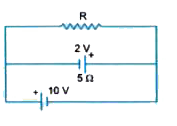Two conductors A and B resistance 5ωand10ω respectively are first joined in parallel and then in series. In each case the voltage applied is 20 V.
Equivalent resistance in series combination is:
15ω
3.33ω
0.3ω
None of the above
The correct Answer is:A
To find the equivalent resistance when two conductors A and B with resistances of 5 ohms and 10 ohms are connected in series, we can follow these steps:
Step 1: Identify the resistances
We have:
- Resistance of conductor A, RA=5Ω
- Resistance of conductor B, RB=10Ω
Step 2: Use the formula for equivalent resistance in series
When resistors are connected in series, the total or equivalent resistance Rs is given by the formula:
Rs=RA+RB
Step 3: Substitute the values into the formula
Now, substituting the values of RA and RB into the formula:
Rs=5Ω+10Ω
Step 4: Calculate the equivalent resistance
Now, perform the addition:
Rs=15Ω
Conclusion
The equivalent resistance when the two conductors are connected in series is 15Ω.
---
We have:
- Resistance of conductor A, RA=5Ω
- Resistance of conductor B, RB=10Ω
When resistors are connected in series, the total or equivalent resistance Rs is given by the formula:
Rs=RA+RB
Now, substituting the values of RA and RB into the formula:
Rs=5Ω+10Ω
Now, perform the addition:
Rs=15Ω
The equivalent resistance when the two conductors are connected in series is 15Ω.
Similar Questions
Two conductors A and B of resistances 5Ωand10Ω respectively are first joined in parallel and then in series. In each case the voltage applied is 20V.
(a) Draw the circuit diagram to show the combination of these conductors in each case.
(b) In which combination will the voltage across the conductors A and B be the same?
(c ) In which arrangement will the current through A and B is the same?
(d) Calculate the equivalent resistance for each arrangement.View SolutionTwo resistors X and Y of resistances 2 ω and 3 ω respectively are first joined in parallel and then in series. In each case the voltage supplied is 5 V.
(i) Draw circuit diagrams to show the combination of resistors in each case.
(ii) Calculate the voltage across the 3 Q resistor in the series combination of resistors.View Solution
Knowledge Check
- Question 1 - Select One
Two conductors A and B resistance 5ωand10ω respectively are first joined in parallel and then in series. In each case the voltage applied is 20 V.
Equivalant resistance in parallel combination is:A15ωB3.33ωC0.3ωDNone of the above - Question 2 - Select One
Two conductors A and B resistance 5ωand10ω respectively are first joined in parallel and then in series. In each case the voltage applied is 20 V.
In which combination will the voltage across the conductors A and B be the same ?ASeries arrangmentBParallel arrangementCBoth of the aboveDNone of the above - Question 3 - Select One
Two conductors A and B resistance 5ωand10ω respectively are first joined in parallel and then in series. In each case the voltage applied is 20 V.
In which arrangment will the current through A and b be the same ?ASeries arrangmentBParallel arrangementCBoth of the aboveDNone of the above
Two cells, of voltage 10 V and 2 V and internal resistances 10Ω and 5Ω respectively, are connected in parallel as shown in Fig. Find the effective voltage and effective resistance of the combination.
 View Solution
View SolutionTwo cells of emfs 1.5 V and 2.0 V having internal resistances 0.2Ω and 0.3Ω respectively are connected in parallel. Calculate the emf and internal resistance of the equivalent cell.
View SolutionTwo cells of emfs 1.5 V and 2.0v having internal resistance 0.2Σ and 0.3 Σ respectively are connected in parallel . Calculate the emf and internal resistance of the equivalent cell .
View SolutionTwo conductors A and B resistance 5ωand10ω respectively are first joined in parallel and then in series. In each case the voltage applied is 20 V.
Which of these circuit diagram shows the correct connection when A and B are joined in parallel?View SolutionThree resistances, each of1Ω are joined in parallel. Three such combinations are put in series. The equivalent resistance is given by
View Solution

